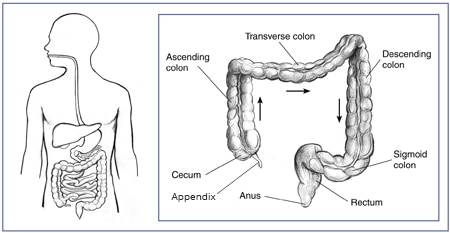About the Lower GI Tract
What is the lower GI tract?
The lower gastrointestinal (GI) tract is the last part of the digestive tract. The lower GI tract consists of the large intestine and the anus.
The large intestine absorbs water and changes the waste products of the digestive process from liquid into formed stool. The large intestine includes
- the appendix, a finger-shaped pouch attached to the cecum
- the cecum, the first part of the large intestine, which is connected to the end of the small intestine
- the colon, which has four sections: the ascending colon, the transverse colon, the descending colon, and the sigmoid colon
- the rectum, the lower end of the large intestine leading to the anus
The anus is a 1-inch opening at the end of your digestive tract through which stool leaves your body. The anus includes the sphincter muscles—muscles that open and close and allow you to control bowel movements.

What are anatomic problems of the lower GI tract?
Anatomic problems of the lower GI tract are problems related to the structure of the lower GI tract. The parts of the lower GI tract may be in the wrong place, may not be shaped normally, or may not connect normally to other parts of the body.
Some anatomic problems of the lower GI tract arise when the lower GI tract does not develop normally before birth. These are called birth defects and include
Other anatomic problems, which might be present at birth or develop later, include
This content is provided as a service of the National Institute of Diabetes and Digestive and Kidney Diseases
(NIDDK), part of the National Institutes of Health. NIDDK translates and disseminates research findings to increase knowledge and understanding about health and disease among patients, health professionals, and the public. Content produced by NIDDK is carefully reviewed by NIDDK scientists and other experts.

